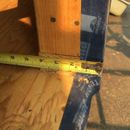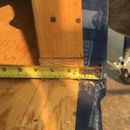Need help figuring out my front door jamb length
This will be my first time installing a front door and I am a bit confused what size door jamb to get.
I have 2×4 framing and important to note this is a tiny house on wheels (on trailer). I have yet to decide the thickness of my interior siding but most likely will be 1/2″.
My exterior will be 1 5/8″ (1/2″ plywood + 3/8″ rainscreen + 3/4″ t&g cedar). This would be 5 1/8″ thickness total.
Does this mean I need a longer door jamb? My sizing seems pretty common so I wouldn’t think so.
Is the door jamb supposed to be flush with my exterior plywood or my cedar siding?
I can tell this will be one of those things that is easy to figure out after one instalation but having trouble visualizing.
I also attached a picture of my front door ro.
GBA Detail Library
A collection of one thousand construction details organized by climate and house part











Replies
I think I may have made this more confusing than it should be. After some more research online, the jamb should be flush with interior siding and slightly proud of the exterior sheathing (3.5+ .5 + .5 = 4.5).
Is this correct?
Grey Wolf,
It depends on whether the trim you are using around your door is doing to be installed directly onto the rain-screen furring (and the siding butted up against it), or on top of the siding.
In the first case the door frame extends flush with the furring, in the second flush with the siding.
Remember that where the trim goes alters where the head flashing will be.
I meant that if the trim is being installed on top of the siding , the head flashing goes directly over the door. If it is being installed on the sheathing, the head flashing goes over the head trim.
I don't flash the door to the sheathing. I flash the rough opening, nail whatever trim I am using onto the door (as you would a brick moulding), and then install the door, bedding the trim in caulking around the opening.
Malcolm, thanks for clarifying. I will be trimming before any rain-screen (furring strips) or siding goes up. So the trim will be installed right over the house-wrap. So a 4 9/16 should be fine?
Good reminder about the head flashing. I assume you mean the drip cap extending over the trim (and not just flush to end of door)?
Also,do I flash the sides of the door (before trim) with tape in the same method the side of window flanges are taped?
Cool, makes sense about the head flashing.
So what exactly is air-sealing the gaps on the sides of the door? I am trying to figure out the best way to achieve my exterior (plywood) air barrier. Looks like tape is not really an option without it showing (and expanding foam is me best option?)? Or can I just tape the gaps and then trim over?
Grey Wolf,
The seal the air leaks between the rough opening and the door jambs, most builders used canned spray foam. For a better air seal, some builders use one of the European tapes. If you use tape, you have to be careful when you apply to tape to the jamb so that the tape isn't visible after the casing is installed.
If you are trying to decide whether to install the tape on the inside or the outside -- either way can work, but putting the tape on the inside is usually preferred.
Grey Wolf, for the best airtightness and water resistance, I seal the sheathing (or air barrier/WRB) directly to the face of the jamb with a good, thin, acrylic tape. Doors often come with exterior casing attached; if that's the case, the casing needs to be removed first. If possible, order a door without casing.
The tape just laps 3/8" or so onto the face of the jamb, and the exterior casing covers it. After the exterior casing is installed, fill the gap from the interior with low-expansion canned spray foam. Make sure it's low-expansion, or "window + door" foam, and start off with less foam than you think you need, because it can expand a lot and cause problems if you don't.
The jamb is usually just a bit proud of the exterior face of the sheathing and the interior face of the drywall (or other interior finished surface). There are other ways to do it, such as when you have extra-thick walls, but it sounds like you should be fine with 4 9/16" jambs.
Martin -
Are you saying to tape the interior door jam to the door frame (before interior siding is on) before interior trim? I attached a picture what I mean (sorry it wouldn't let me add the youtube video, saying it was spam).
The concept totally makes sense just a bit difficult to plan without ever installing an exterior door. Do you happen to know if there are any guides online that show taping around the door jams?
Michael- My sheathing is my exterior barrier so should I pull back the housewrap (to tape the plywood to the door jam) and not fold the housewrap into the rough window frame like I do with windows? This is assuming there is no brickmold.
Would it look something like this video?
What I am still unsure about, is if the house usually folds in the door frame and taped or if it runs flush to the door cutout. Can't really find a good tutorial online that I am looking for.
It seems like a door with a nailing fin would be superior?
Thanks for the help, guys.
Michael, here is the video - it wouldn't let me post on previous comment for some reason http://www.askthebuilder.com/exterior-door-insulation-video/
Grey, there are many ways to install a door, and many of them work fine in conventional situations. I was just describing what I do when higher performance is required. I just installed a new front door at my own house but didn't take enough photos of that phase of the project. I took a quick look for Fine Homebuilding or JLC articles but don't see any with my approach. I skimmed through your video and that approach may work ok, but I've installed a lot of doors and think it's easier to do it the way I described.
You can keep the housewrap in place and just tape onto the face of it. Except at the header; there, it's best to cut a slit and tuck your flashing under the housewrap, then seal the cut with tape. Doors are heavy and see a lot of abuse so I would not want to rely on a flange to do everything. In fact I don't even like flanges on regular windows, if high performance is a goal; I tape them the same way I described for the door. That's common in Europe, but not how most Americans do it.
Don't let me throw you off; Martin's giving you good advice.
Grey Wolf,
If you are using tape on the interior, you would tape the door jamb to the nearby studs and the header (the rough opening).
No doubt, Michael. Both sound like excellent suggestions by you guys.
I will get a front door WITHOUT the brickmold because I see no advantage to it (and my plans call to have two 2x6 trim on the side of each door).
I drew a quick sketch, but this is what I am planning on doing (based on the advice given from both of you):
1) Fold back house-wrap temporarily and Tape exterior door jam to plywood sheathing (over the rough opening gap).
2) Tape (again) house-wrap to exterior door jam.
3) Trim over this.
For interior, I plan to fill with roxul insulation and then tap over the rough opening gap door jam to stud, as Martin said.
How does that sound? And is step 2 sufficient to keep water out of the door (For my windows, I wrapped the house-wrap and taped slightly inside of the frame)? I figure because I am taping the gap before house-wrap goes over, it should be good.
Grey, for the most part your approach makes sense--first completing your air barrier, then completing your WRB. The weak spot is the fact that doors almost always leak at some point, so a sill pan is highly recommended, and should be integrated into the WRB. Here's a good video on flexible sill pans: https://foursevenfive.com/heavy-duty-window-flashing-by-chris-corson-using-extoseal-encors/. (I helped install the floor-to-ceiling windows, among other tasks, on the house in the video, but that's beside the point.) For high performance, I would wrap the WRB into the opening, tape it to the jack studs and header to complete your air barrier. Then just let the tape span the gap on the exterior to complete the WRB.
Weill definitely include the sill pan. I actually have some extoseal. It seems to get punctured easy so I was planning on laying that down, then a product called suresill over that (pvc sill pan).
Thing is- My plywood sheathing is my air barrier, not my house-wrap. So If I tape the jams to plywood, I can no longer wrap the WRP into the opening (and taped to the jack studs).
I could skip taping the exterior sheathing to the jam (will still tape housewrap to jam of course) and just rely on the interior taping (stud to jam) for my exterior air barrier.
I guess it boils down to what's more important - wrapping the housewrap into the opening (vs flush with jam) or maintaining my plywood sheathing as an exterior air barrier, which I have worked hard to achieve.
You can transition the air barrier from exterior to interior by taping the corners of your rough opening (where studs meet header and where sheathing meets studs) and then taping from studs to jamb on the interior side of the wall, as Martin had suggested.
Excellent. Thank you!